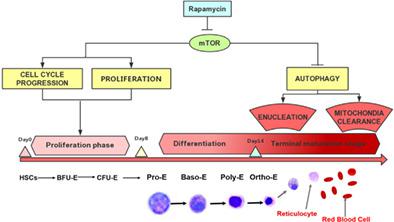当前位置:
X-MOL 学术
›
STEM CELLS
›
论文详情
Our official English website, www.x-mol.net, welcomes your
feedback! (Note: you will need to create a separate account there.)
The opposing roles of the mTOR signaling pathway in different phases of human umbilical cord blood-derived CD34+ cell erythropoiesis
STEM CELLS ( IF 4.0 ) Pub Date : 2020-09-01 , DOI: 10.1002/stem.3268 Qian Liu 1, 2 , Linhong Luo 3 , Chunhong Ren 4 , Muping Zou 1 , Siqin Yang 1 , Bozhi Cai 1 , Libiao Wu 1 , Yunsheng Wang 1 , Shan Fu 2 , Xu Hua 2 , Nianping Tang 2 , Shiping Huang 2 , Xianxi Huang 5 , Wen Xin 6 , Feiheng Chen 7 , Xin Zhang 1, 2, 8, 9
STEM CELLS ( IF 4.0 ) Pub Date : 2020-09-01 , DOI: 10.1002/stem.3268 Qian Liu 1, 2 , Linhong Luo 3 , Chunhong Ren 4 , Muping Zou 1 , Siqin Yang 1 , Bozhi Cai 1 , Libiao Wu 1 , Yunsheng Wang 1 , Shan Fu 2 , Xu Hua 2 , Nianping Tang 2 , Shiping Huang 2 , Xianxi Huang 5 , Wen Xin 6 , Feiheng Chen 7 , Xin Zhang 1, 2, 8, 9
Affiliation

|
As an indispensable, even lifesaving practice, red blood cell (RBC) transfusion is challenging due to several issues, including supply shortage, immune incompatibility, and blood‐borne infections since donated blood is the only source of RBCs. Although large‐scale in vitro production of functional RBCs from human stem cells is a promising alternative, so far, no such system has been reported to produce clinically transfusable RBCs due to the poor understanding of mechanisms of human erythropoiesis, which is essential for the optimization of in vitro erythrocyte generation system. We previously reported that inhibition of mammalian target of rapamycin (mTOR) signaling significantly decreased the percentage of erythroid progenitor cells in the bone marrow of wild‐type mice. In contrast, rapamycin treatment remarkably improved terminal maturation of erythroblasts and anemia in a mouse model of β‐thalassemia. In the present study, we investigated the effect of mTOR inhibition with rapamycin from different time points on human umbilical cord blood‐derived CD34+ cell erythropoiesis in vitro and the underlying mechanisms. Our data showed that rapamycin treatment significantly suppressed erythroid colony formation in the commitment/proliferation phase of erythropoiesis through inhibition of cell‐cycle progression and proliferation. In contrast, during the maturation phase of erythropoiesis, mTOR inhibition dramatically promoted enucleation and mitochondrial clearance by enhancing autophagy. Collectively, our results suggest contrasting roles for mTOR in regulating different phases of human erythropoiesis.
中文翻译:

mTOR信号通路在人脐带血CD34+细胞红细胞生成不同阶段的相反作用
作为一种不可或缺的、甚至可以挽救生命的做法,由于捐献的血液是红细胞的唯一来源,因此由于供应短缺、免疫不兼容和血源性感染等几个问题,红细胞 (RBC) 输血具有挑战性。尽管从人类干细胞中大规模体外生产功能性红细胞是一种很有前景的替代方法,但由于对人类红细胞生成机制的了解不足,到目前为止,还没有报道称这种系统可以生产临床可输注的红细胞,这对于优化红细胞生成至关重要。体外红细胞生成系统。我们之前曾报道,抑制哺乳动物雷帕霉素靶蛋白(mTOR)信号显着降低了野生型小鼠骨髓中红系祖细胞的百分比。相比之下,雷帕霉素治疗显着改善了β-地中海贫血小鼠模型中成红细胞的终末成熟和贫血。在本研究中,我们研究了不同时间点雷帕霉素抑制 mTOR 对体外人脐带血 CD34+ 细胞红细胞生成的影响及其潜在机制。我们的数据表明,雷帕霉素处理通过抑制细胞周期进程和增殖显着抑制红细胞生成的定型/增殖阶段的红细胞集落形成。相比之下,在红细胞生成的成熟阶段,mTOR 抑制通过增强自噬显着促进去核和线粒体清除。总的来说,我们的结果表明 mTOR 在调节人类红细胞生成的不同阶段中的作用不同。
更新日期:2020-09-01
中文翻译:

mTOR信号通路在人脐带血CD34+细胞红细胞生成不同阶段的相反作用
作为一种不可或缺的、甚至可以挽救生命的做法,由于捐献的血液是红细胞的唯一来源,因此由于供应短缺、免疫不兼容和血源性感染等几个问题,红细胞 (RBC) 输血具有挑战性。尽管从人类干细胞中大规模体外生产功能性红细胞是一种很有前景的替代方法,但由于对人类红细胞生成机制的了解不足,到目前为止,还没有报道称这种系统可以生产临床可输注的红细胞,这对于优化红细胞生成至关重要。体外红细胞生成系统。我们之前曾报道,抑制哺乳动物雷帕霉素靶蛋白(mTOR)信号显着降低了野生型小鼠骨髓中红系祖细胞的百分比。相比之下,雷帕霉素治疗显着改善了β-地中海贫血小鼠模型中成红细胞的终末成熟和贫血。在本研究中,我们研究了不同时间点雷帕霉素抑制 mTOR 对体外人脐带血 CD34+ 细胞红细胞生成的影响及其潜在机制。我们的数据表明,雷帕霉素处理通过抑制细胞周期进程和增殖显着抑制红细胞生成的定型/增殖阶段的红细胞集落形成。相比之下,在红细胞生成的成熟阶段,mTOR 抑制通过增强自噬显着促进去核和线粒体清除。总的来说,我们的结果表明 mTOR 在调节人类红细胞生成的不同阶段中的作用不同。











































 京公网安备 11010802027423号
京公网安备 11010802027423号